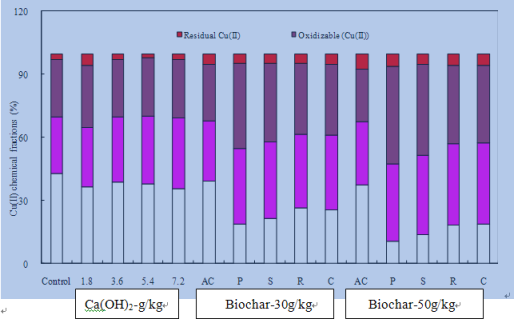|
|
| Application of crop straw derived biochars to Cu(II) contaminated Ultisol: Evaluating role of alkali and organic functional groups in Cu(II) immobilization |
TEXT SIZE: A A A |
| 2013-11-19 |
In present study, an actual Cu(II) contaminated Ultisol was collected near a copper smelting plant to assess the relative contributions of the different mechanisms in Cu(II) immobilization, i.e. precipitation due to the increase of soil pH induced by alkaline substances from biochars and surface complexation between Cu(II) and organic functional groups on biochars. When Cu(II) contaminated Ultisol was mixed with biochar derived from straw and incubated for 120 d, acid-soluble Cu(II) (active Cu(II)) decreased by 0.08–0.33 mmol/kg due to the liming effect of biochar; 1.00–1.93 mmol/kg due to organic functional groups of biochar when it was added to the soil at 30 g/kg, and by 1.40–2.43 mmol/kg at 50 g/kg. The total functional groups were significantly related to Cu(II) immobilization (P < 0.01), suggesting that functional groups play an important role in Cu(II) immobilization in soil. The percentage of acid soluble Cu(II) decreased from 43.07% for the control, to 18.83–27.45% and 11.03–20.97% for the treatments with 30 and 50 g/kg of crop straw biochars added, respectively. The immobilized Cu(II) was primarily transformed to reducible and oxidizable forms. Biochar from legume straw was more effective than that from non-legume straw, and the pyrolysis at 400 ºC was optimum for producing biochar for Cu(II) immobilization in acid soils. Biochar could retain Cu(II) for at least 120 d, indicating the long-term stability of biochar in Cu(II) immobilization. (Jiang J, Xu RK. 2013. Application of crop straw derived biochars to Cu(II) contaminated Ultisol: Evaluating role of alkali and organic functional groups in Cu(II) immobilization. Bioresource Technology 133: 537-545)
|

|
|
Percentage of four chemical fractions of Cu(II) determined by BCR sequential extraction (P, S, R, C represent biochars from the straw of peanut, soybean, rice, and canola, respectively) |
 |
 |
|
|
